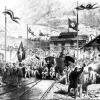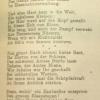An association without a nation? The Verein Deutscher Eisenbahnverwaltungen

Festive Greeting (Festgruss) - song sung at the 40th Anniversary of the Verein in 1886.
The growth of railways in the first half of the nineteenth century raised new questions about borders and rules.
Nowhere were these questions more acute than in the numerous small states of Germany, with its multiple borders. In 1834, not long after the first railway in Germany opened between Nuremberg and Fürth, a number of German states, led by Prussia, created the German Customs Union to help speed up commerce over borders. For many railway experts, the limits of this customs union, especially its end at the borders of the Austrian Empire, did not go far enough. Twelve years later, in 1846, ten railway organizations created the Verein Deutscher Eisenbahn Verwaltungen (Union of German Railway Administrations, popularly known as The Verein), the first transnational railway institution in Europe.
Whereas the German customs union stayed limited, and in fact shrunk after the Austro-Prussian war of 1866, the Verein expanded well beyond political boundaries and soon represented over eighty-two railways in Germany, Austria-Hungary, the Netherlands, Belgium, and Russia. The Verein consisted of a combination of state-owned and non-state railways, dominated by experts who studied the development of railways at length. To railway experts, the Verein was a place where they could study the development of railways, exchange knowledge, and perform technical tests on a personal and informal basis. The standards developed by the Verein eventually found their way into the Berne Convention for the International Transport of Goods by Rail in 1882 and 1886.
In response to the Franco-German war of 1870–71 (which resulted in Germany's unification in 1871), the French created the rival Congrès International des Chemins de Fer (International Railway Congres). Thus, in Europe, various governing bodies built the foundations for European railway integration. The involvement of a variety of governing bodies in railway governance remains the rule today.
 Previous Story
Next Story
Previous Story
Next Story
How to cite this page
Suzanne Lommers, 'An association without a nation? The Verein Deutscher Eisenbahnverwaltungen', Inventing Europe, http://www.inventingeurope.eu/story/an-association-without-a-nation-the-verein-deutscher-eisenbahnverwaltungen
Sources
- Bulletin de la Commission Internationale Du Congrès des Chemins de Fer. 1887-1896.
- “Festschrift über die Thätigkeit des Vereins Deutscher Eisenbahn-Verwaltungen in den ersten 50 Jahren seines Bestehens 1846-1896”. Berlin: Nauck, 1896.
- Kaiser, Wolfram, Johan Schot, and Dagmara Jajesniak-Quast. Making Rules for Europe:
Experts, International Organizations, Cartels. Basingstoke: Palgrave, forthcoming. - Zeitung des Vereins deutscher Eisenbahn-Verwaltungen. 1961-1893.



















